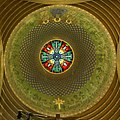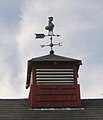Cupola
In architecture, a cupola /ˈkjuːpələ/ is a relatively small, most often dome-like, tall structure on top of a building.[1] Often used to provide a lookout or to admit light and air, it usually crowns a larger roof or dome.[2][3]
The word derives, via Italian, from the lower Latin cupula (classical Latin cupella from the Greek κύπελλον kupellon) "small cup" (Latin cupa) indicating a vault resembling an upside down cup.[4]
The cupola is a development during the Renaissance of the oculus, an ancient device found in Roman architecture, but being weatherproof was superior for the wetter climates of northern Europe. [citation needed] The chhatri, seen in Indian architecture, fits the definition of a cupola when it is used atop a larger structure.[citation needed]
Cupolas often appear as small buildings in their own right. They often serve as a belfry, belvedere, or roof lantern above a main roof. In other cases they may crown a spire, tower, or turret.[3] Barns often have cupolas for ventilation.[5]
The square, dome-like segment of a North American railroad train caboose that contains the second-level or "angel" seats is also called a cupola.[6][7]
Some armored fighting vehicles have cupolas, called commander's cupola, which is a raised dome or cylinder with armored glass to provide 360-degree vision around the vehicle.[8]
Gallery
-
Cupolas on the towers of Montefiascone Cathedral, Italy.
-
Ribbed cupola crowns the minaret of the Mosque of Uqba, in Kairouan, Tunisia.
-
Inside of Armenian Orthodox church cupola in Lviv, Ukraine.
-
Cupolas were also used on some old barns for ventilation.
-
A cupola-style caboose with an "angel seat" above
-
View from the interior of Cupola module on the International Space Station.
-
Optical illusion of a cupola in a church in Northern Italy (Brivio)
See also
References
- ^ "Glossary of Architectural Terms - C". Archiseek: Online Architecture Resources. Archived from the original on 27 December 2008. Retrieved 3 January 2009.
{{cite web}}: Unknown parameter|deadurl=ignored (|url-status=suggested) (help) - ^ "cupola". The American Heritage Dictionary of the English Language, Fifth Edition. Houghton Mifflin Harcourt Publishing Company. 2014. Retrieved 26 April 2015.
- ^ a b "Just what is a cupola anyway?". Cupola Consulting. Retrieved 3 January 2009.
- ^ In Italian cupola simply means dome, and the ornamental top element is called lanterna.
- ^ "What is a cupola and why do barns have them?". Retrieved 15 November 2015.
- ^ "Railroad Dictionary: A". CSX.com. CSX Transportation. Archived from the original on 1 August 2015. Retrieved 18 September 2014.
{{cite web}}: Unknown parameter|deadurl=ignored (|url-status=suggested) (help) - ^ Zabel, Darcy (2005). The (Underground) Railroad in African American Literature. Peter Lang. p. 5. ISBN 9780820468167.
- ^ Bradford, George. Axis Armored Fighting Vehicles: 1/72 Scale.









